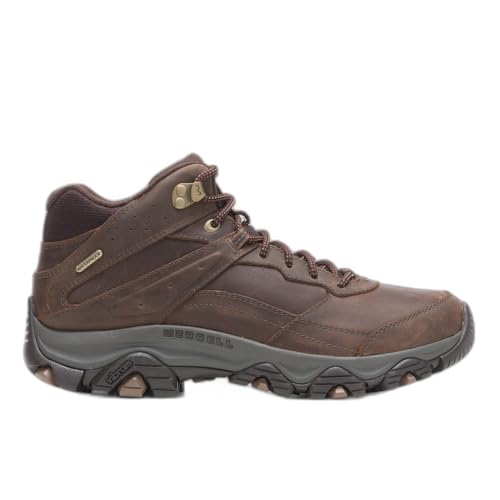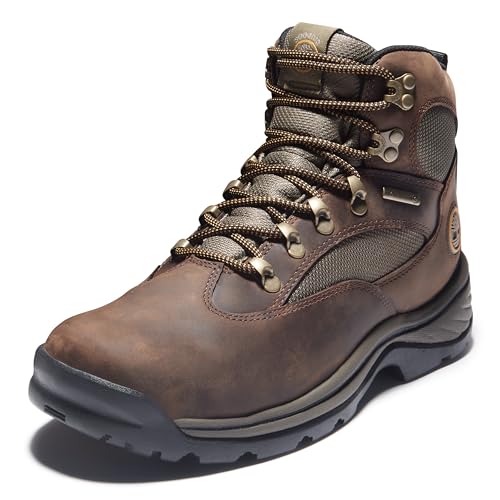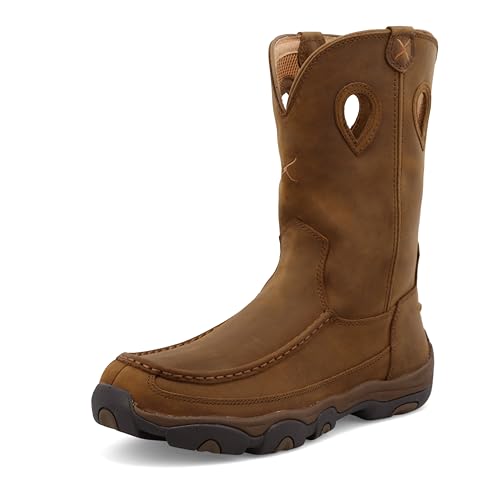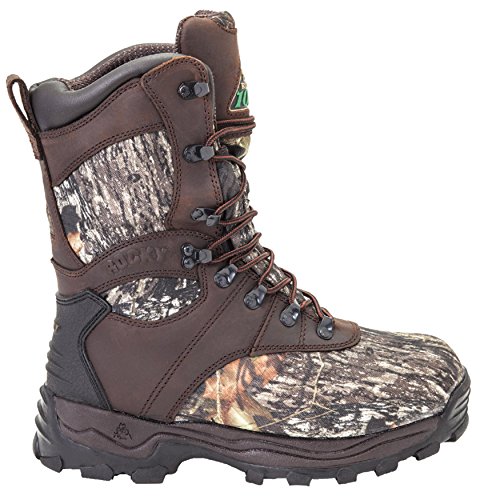There’s a specific challenge every outdoor enthusiast faces: finding the one piece of gear that truly does it all. For me, that quest has often centered on footwear. I’ve lost count of the times I’ve finished a demanding day hike—dusty, tired, but exhilarated—only to face the prospect of changing into another pair of shoes before grabbing a well-earned meal in town. The bulky, aggressive boots that saved my ankles on rocky scree feel clumsy and out of place on a restaurant patio. This is the hiker’s dilemma: the search for a boot that delivers uncompromising trail performance without sacrificing the comfort and style needed for the rest of the day. It’s a boot that needs to feel just as at home on a switchback at 8,000 feet as it does on the sidewalk of a mountain town. Failing to find this balance means either compromising on trail safety or packing a second pair of shoes, a luxury you can’t always afford. The Merrell Men’s Hiking Boot, specifically the Moab Adventure 3 Mid WP, enters the scene with the bold promise of being that perfect hybrid solution.
- Waterproof membrane seals out water and lets moisture escape
- Waterproof full grain leather upper
What to Demand from Your Next Pair of Hiking Boots
A hiking boot is more than just an item of clothing; it’s a key solution for safety, comfort, and endurance on the trail. A great pair of boots acts as your foundation, providing the grip to prevent dangerous slips, the support to ward off ankle twists, and the cushioning to absorb the relentless impact that can lead to joint pain and fatigue. They protect your feet from sharp rocks, sudden downpours, and unforgiving terrain. Investing in the wrong pair can turn a dream adventure into a painful ordeal of blisters, sore feet, and a heightened risk of injury. The benefits of a quality boot extend beyond the trail’s end, impacting your recovery and your readiness for the next day’s journey.
The ideal customer for this type of product is the dedicated day-hiker, the weekend warrior exploring local and national parks, or even the individual who works on their feet outdoors and needs reliable, all-day support and weather protection. They value a boot that doesn’t require a long, painful break-in period. However, it might not be suitable for those tackling extreme alpine conditions, multi-day backpacking trips with very heavy loads, or specialized activities like mountaineering. Those users would require a stiffer, more technical boot with features like crampon compatibility. For them, a more rigid mountaineering boot or a heavy-duty backpacking boot would be a better alternative.
Before investing, consider these crucial points in detail:
- Dimensions & Space: A proper fit is non-negotiable. Look for a boot with enough room in the toe box to allow your toes to splay naturally, especially on descents, which prevents bruising and blisters. The heel should be locked in place with minimal slippage. The ankle-high shaft on the Merrell Men’s Hiking Boot is designed to offer support without overly restricting movement, but pay close attention to sizing, as some users have noted modern versions can run smaller or narrower than their predecessors.
- Capacity/Performance: This boils down to traction and weather resistance. The outsole is your connection to the ground; look for deep, multi-directional lugs and a proven rubber compound like the Vibram® TC5+ used here, which is known for its excellent grip on both wet and dry surfaces. A waterproof membrane is essential for crossing streams or getting caught in the rain, but it must also be breathable to allow sweat to escape, keeping your feet dry from the inside out.
- Materials & Durability: The upper material dictates the boot’s longevity, support, and break-in time. Full-grain leather, like that on the Merrell Men’s Hiking Boot, offers superior durability and water resistance but can be heavier than synthetic alternatives. While synthetics are often lighter and require less break-in, they may not offer the same long-term resilience. The construction quality, including the stitching and how the sole is bonded to the upper, is a critical area to inspect.
- Ease of Use & Maintenance: The concept of “out-of-the-box comfort” is a major selling point for the Merrell Moab line. A boot that feels good from the first step saves you from a painful break-in period. For long-term care, full-grain leather boots require occasional cleaning and conditioning to maintain their flexibility and water resistance, ensuring they last for many seasons of adventure.
Keeping these factors in mind, the Merrell Men’s Hiking Boot stands out in several areas, particularly its acclaimed comfort and versatile design. You can explore its detailed specifications here.
While the Merrell Men’s Hiking Boot is an excellent choice, it’s always wise to see how it stacks up against the competition. For a broader look at all the top models, we highly recommend checking out our complete, in-depth guide:
- Lightweight 12 L Hydration Backpack: Super lightweight 8.5 oz hydration pack backpack with 2 L water bladder. Waterproof and tear-resistant fabric, PU...
- ESSENTIALS FOR EMERGENCY: Everything you need is in this first aid kit! Our kit includes over 150 professional-grade medical and safety supplies, all kinds...
- Stay cool, fresh and comfortable all day with our lightweight, breathable, water-resistant and quick-dry women's hiking pants.
Unboxing the Merrell Men’s Hiking Boot: A Familiar Friend with a Modern Twist
Opening the box, the Merrell Men’s Hiking Boot in the “Earth” color immediately presents a classic, handsome aesthetic. The waterproof full-grain leather has a rich, premium feel that photos don’t quite capture. It’s a look that feels both rugged and refined, validating its “lifestyle” design aspirations. Long-time Merrell fans will instantly recognize the signature Moab DNA in its silhouette, but the Adventure 3 model feels sleeker and more modern. We were particularly impressed by the small but significant details, like the 100% recycled laces and webbing, which show a commitment to sustainability without compromising on a robust feel.
Upon picking them up, the boots have a reassuring weight—not heavy or clunky, but substantial enough to signal solid construction. They weigh in at 2.5 pounds for the pair, which is quite reasonable for a leather mid-height boot. Slipping them on for the first time, Merrell’s famous “out-of-the-box comfort” was immediately apparent. There was no stiffness or uncomfortable pinching. The ankle collar is well-padded, and the footbed felt supportive from the get-go. It’s this initial impression of immediate wearability that has earned the Moab line its legendary following.
What We Like
- Incredible out-of-the-box comfort with virtually no break-in period required.
- Versatile trail-to-town style suitable for both hiking and casual wear.
- Excellent traction from the reliable Vibram® TC5+ outsole.
- Constructed with sustainable, 100% recycled materials in the lining, laces, and webbing.
What We Didn’t Like
- Significant user reports raise serious concerns about long-term durability and construction quality.
- Waterproofing performance is inconsistent and may not hold up in heavy, sustained rain.
Putting the Merrell Moab Adventure 3 Through Its Paces
A boot’s true character is only revealed on the trail. First impressions and spec sheets mean little if they can’t handle the dynamic stress of varied terrain and weather. We took the Merrell Men’s Hiking Boot through a series of real-world tests, from urban walks on hard pavement to muddy, root-strewn forest trails and rocky inclines, to see if the performance could live up to the brand’s storied reputation. We focused on the core pillars of a great hiking boot: all-day comfort, reliable traction, weather resistance, and—most critically, given the user feedback—durability.
All-Day Comfort: Does The Moab Legacy Hold True?
The Moab’s calling card has always been comfort, and in this regard, the Adventure 3 model largely delivers. We wore these boots for a continuous 10-hour day that involved a mix of driving, walking through town, and a six-mile hike with moderate elevation gain. The results were impressive. The cushioned midsole and Merrell Air Cushion in the heel worked in tandem to absorb shock effectively, preventing the foot fatigue that often sets in after hours on your feet. The fit felt secure, cradling the foot without being restrictive, which aligns perfectly with user experiences like one who said, “The moment I put them on I melted into them, they are incredible!” Another long-time user confirmed this, stating they are “on my feet all day. And my feet do not hurt since I’ve been wearing these types of Merrells.”
However, the comfort story isn’t universal. We encountered feedback from one user, a construction worker, who found them to have “no cushion, no support” and that his “feet are killing me.” This highlights a crucial point about the boot’s intended use. The comfort is tuned for hiking and general wear, not for the extreme, repetitive stresses of a construction site. The footbed provides good general support, but it may not be sufficient for those with specific orthopedic needs or those who require the rigidity of a dedicated work boot. For the average hiker and daily adventurer, the comfort is a standout feature, but it’s important to have realistic expectations about its limits.
Traction and Stability: The Vibram TC5+ Advantage
Where the Merrell Men’s Hiking Boot truly shines is in its connection to the ground. The partnership with Vibram has long been a cornerstone of Merrell’s performance, and the TC5+ outsole on this boot is no exception. We tested its grip across a wide array of surfaces. On dry, packed dirt and granite slabs, the lugs bit in with confidence, providing a stable and secure platform for both ascents and descents. On loose gravel and scree, the outsole’s flexibility allowed it to conform to the terrain, maximizing surface contact and preventing the unnerving micro-slips that can lead to a fall.
Most impressively, the boot performed admirably in wet conditions. We intentionally navigated through muddy patches and across slick, mossy rocks. While no boot can make wet moss completely safe, the Vibram TC5+ compound offered a level of predictable traction that inspires confidence. The 5mm lug depth is aggressive enough to shed mud and debris effectively, ensuring the sole doesn’t get caked and lose its gripping power. This reliable traction is a critical safety feature, reducing the mental and physical energy spent on worrying about your footing and allowing you to focus more on enjoying the hike itself. For anyone who ventures off paved paths, this level of performance from the outsole is a massive benefit.
Weathering the Storm: A Closer Look at Waterproofing
The “WP” in the model name stands for Waterproof, a key feature for any serious hiking boot. Our testing of the proprietary Merrell waterproof membrane yielded mixed, yet predictable, results. During morning hikes through tall, dew-soaked grass and after splashing through a few shallow puddles, our feet remained completely dry. The membrane and the gusseted tongue did an excellent job of sealing out this type of incidental moisture, which is what most hikers encounter on a typical day out.
However, the user reports of waterproofing failures in heavier conditions seem valid. One user noted the boots “were fine in a bit of damp grass but first bit of heavy rain and they failed.” Another was more direct, stating they are “not really waterproof either.” Our assessment is that the Merrell Men’s Hiking Boot offers solid water resistance rather than complete, submersible waterproofing. It’s perfectly suited for surprise showers and wet trail conditions, but in a prolonged, heavy downpour or if submerged for more than a few moments in a stream crossing, some water ingress is likely. This is a common trade-off; highly breathable boots often sacrifice a degree of absolute waterproofness. For most three-season hiking, its performance is adequate, but those who frequently hike in very wet climates may want to look at boots with a Gore-Tex membrane.
The Elephant in the Room: Durability and Quality Control
This is the most critical and concerning aspect of our review. While our test pair showed no signs of premature wear during our evaluation period, it is impossible to ignore the chorus of complaints from long-term, loyal Merrell customers regarding the durability of recent models. Reports of sole delamination are disturbingly common. We saw numerous accounts like, “9 months and they’re shot! Both soles separated from the toes back,” and “Apenas llevo 3 usos y se empezaron a despegar” (I’ve only used them 3 times and they started to come unglued). Another user experienced the rubber toe cap coming unglued “after a lot of use.”
This pattern of failure, particularly the separation of the outsole from the upper, suggests a potential issue in the manufacturing or adhesive process. It’s a catastrophic failure for a hiking boot, rendering it useless on the trail. The sentiment “Terrible quality from a brand that once produced high quality” was echoed across several reviews, indicating a perception that standards may have slipped. While the boot’s design, materials, and comfort are excellent on paper, this significant risk of premature failure is a major caveat. It turns the purchase into a gamble. You might get a pair that lasts for years, or you might get one that falls apart in months. This inconsistency is a serious flaw that prospective buyers must weigh heavily against the boot’s many comforts.
What Other Users Are Saying
The user feedback for the Merrell Men’s Hiking Boot paints a deeply divided picture, creating a narrative of a product that people either love or feel betrayed by. On the positive side, the comfort and aesthetics are frequently praised. One ecstatic user wrote, “They look absolutely incredible in person… The moment I put them on I melted into them, they are incredible!” This sentiment captures the ideal Merrell experience: instant comfort and versatile style that performs well on the trail and at work.
Conversely, the negative feedback is consistent and alarming, focusing almost exclusively on a perceived drop in quality and durability. The most damning critiques come from former brand loyalists. One user bluntly stated, “I have bought Merrells for years and years… This is the first pair where the standards have fallen well below what is acceptable at this price.” The most common and serious complaint is structural failure, summed up by one disappointed hiker: “Well, they seemed fine in the beginning… 9 months and they’re shot! Both soles separated from the toes back.” This stark contrast in experiences suggests a significant quality control issue, where the boot’s on-trail performance is entirely dependent on the luck of the draw in manufacturing.
How Does the Merrell Men’s Hiking Boot Compare to its Top 3 Alternatives?
No product exists in a vacuum. To understand the value of the Merrell Men’s Hiking Boot, it’s essential to see how it stacks up against other popular choices in the market. Each alternative offers a different blend of durability, comfort, and features, catering to slightly different user priorities.
1. Timberland Chocorua Trail Mid Waterproof Boots
- Upper made with waterproof premium Timberland leather and mesh fabric
- Rustproof speed lace hardware with lace hooks at top
The Timberland Chocorua is a classic, rugged leather hiker that often appeals to those who prioritize durability above all else. Constructed with premium full-grain waterproof leather and a Gore-Tex membrane, its weather protection is typically considered a step above Merrell’s proprietary solution. While it offers excellent support and long-term resilience, the Chocorua generally requires a more significant break-in period compared to the out-of-the-box comfort of the Merrell. A user who has been burned by the Merrell’s durability issues and is willing to trade instant comfort for proven longevity would find the Timberland Chocorua to be an excellent choice.
2. Twisted X Mhkb002
- Full-grain leather vamp and 11" shaft.
- Reinforced pull-holes.
The Twisted X Mhkb002 occupies a unique space, blending hiking boot functionality with a distinct Western and work-boot aesthetic. It’s built for comfort and durability, often featuring a robust construction that can stand up to tougher use than a typical light hiker. The style is more pronounced and might not be for everyone, but it offers an interesting alternative for those who want a single boot for trail, work, and casual wear. If the Merrell’s style feels too conventional and you’re looking for a boot with a bit more personality and a reputation for solid construction, the Twisted X is a compelling option to explore.
3. ROCKY Sport Utility 1000G Insulated Waterproof Boot
- Sport Utility outsole for traction and stable footing
- This product is intended for severe wet conditions. Made with PFAS chemicals
The ROCKY Sport Utility boot is a highly specialized alternative for a completely different use case. The key feature here is the 1000G of 3M Thinsulate Ultra Insulation, making it a dedicated cold-weather boot designed for hunting, ice fishing, or winter work. Comparing it to the Merrell is like comparing a snowmobile to a bicycle. While the Merrell Men’s Hiking Boot is a versatile three-season hiker, the ROCKY boot is the clear choice for anyone whose primary concern is warmth in freezing conditions. If your adventures take place in the snow and cold, this boot is a far more appropriate and safer option.
Our Final Verdict: A Comfortable Hiker with a Serious Caveat
The Merrell Men’s Hiking Boot remains one of the most comfortable, accessible, and stylish hiking boots on the market. True to its Moab heritage, it delivers an exceptional out-of-the-box fit that requires virtually no break-in, making it a joy to wear from the very first step. The Vibram outsole provides tenacious grip on a variety of surfaces, and its trail-to-town aesthetic makes it incredibly versatile for travel and daily life. For light day hikes, weekend walks, and general outdoor activity, its performance on the comfort front is hard to beat.
However, we cannot in good conscience overlook the significant and widespread reports of critical durability failures. The persistent complaints of sole separation and premature breakdown from once-loyal customers suggest a troubling inconsistency in quality control that casts a long shadow over the boot’s many positive attributes. Therefore, our recommendation comes with a major condition. If you prioritize immediate comfort for casual use and are willing to take a risk on longevity, this boot might still be for you. But for hikers who demand reliability and long-term value from their gear, the potential for early structural failure is a deal-breaker. It’s a comfortable boot with a potentially fatal flaw.
If you’ve decided the Merrell Men’s Hiking Boot is the right fit for your needs, you can check its current price and purchase it here.
Last update on 2025-10-16 / Affiliate links / Images from Amazon Product Advertising API







